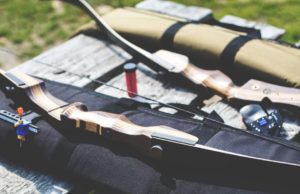- Best Archery Accessories 2024 - March 19, 2022
- Bow string:Why does it keep hitting my arm? - February 2, 2022
- Bow square: A how to guide - February 2, 2022
One of the fundamental skills in longbow or recurve archery is removing and stringing your bow. First, you need to know how to unstring and assemble your recurve bow.
Secondly, if you are planning to use a stringer, you need to know how to use one and distinguish if it is necessary to use a stringer. Lastly, you need to know how long the bowstring lasts and if you can leave the string on the bow if you are not using it.
To answer all the questions, make sure to read everything here.
Stringing the Bow for the First Time
Depending on your archery skills, the first step we will discuss is how to assemble the recurve bow.
First, you start by screwing the limb bolts together on the riser slots using the hand or a hex wrench. Alternatively, you can screw the pins into the limb and fit the arm to the riser slot afterward.
Now if you have received your bow with it strung and used it for a long time in need of replacing the string the bow stringer does play an important role.
The device is cheap and is a length of cord with leather pocket found at each end. For removing and stringing a bow, the gadget makes things more comfortable and safer.
We are not saying that you cannot unstring or string the bow using only your hand, but it can come with injuries if the bow limb slips causing injury or damage to the bow.
Steps in unstringing your bow:
- Place the larger pocket of the stringer over the lower limb and make sure it is a snug fit.
- Take the smaller pocket (saddle) and place it over the upper limb. You may find that some brands you need to hold the saddle in place with the hand for the rest of this process.
- With the bow, horizontally hold it with your dominant hand near the tip of the upper limb. Place the other hand on the middle handle positioned closer to the string side closest to the ground parallel to it.
- Stand with both your feet on the stringer cord at shoulder-width apart. Keep your feet stable with the cable secure beneath it.
- Now pull the bow from the handle until the string is slack as the stringer starts taking up the tension.
- Start by unhooking the bowstring at the upper end out of the nock to prevent dragging on the ground and leave it hanging on the upper limb.
- Now it is time to remove the lower limb string as well.
- Slowly lower the bow so that the stringer cord becomes slack and the limbs remain in a relaxed position.
- Remove the bowstring and stringer.
So how do you string the recurve bow using the stringer?
Using a bow stringer prevents damaging the limbs of the bow as well as accidents.
- Place the bigger ring of the stringing tool over the top limb, snap the gripper onto it, and glide it down until it no longer slides.
- Take the strings larger loop and lug it through the bigger loop of the stringer. Now place the larger loop onto the top limb and slip it down until flush with the gripper of the stringer.
- Now take the smaller loop of your bowstring and slip the bottom limb through it. Always make sure the loop fit into the groove at the top of the limb.
- Take the stringers smaller loop and glide the bottom limb through. Snap the gripper onto the limb and slide it down until it cannot glide further.
- Now lower the bow riser to the floor and step over the stringer only with your feet. Pull the recurve upwards with your one arm and use the 2nd arm to slip the larger loop of the string into the groove of the limb.
That is all you need to do to get your recurve bows string on and ready for shooting. Furthermore, make sure the bowstrings positioned inside the grooves of the limbs.

Stringing the Bow without a Stringer
Now if you want to string your recurve bow the old-fashioned way it is possible without using the stringer tool. However, you will need to use your muscle power with the foot bracing method. Furthermore, this technique works best with lightweight longbows and recurve bows.
- Place the string loop on the upper limb.
- Put the lower bowstring loop on the nock.
- Place the lower limb at the inside of your foot and hold it in place securely.
- Take your dominant hand and pull the bow while the opposite one bends the bow.
- Take your top hand at the upper limb and put the string in place in the groove.
The critical thing when stringing your bow without a stringer is to wear work boots with heavy soles to add weight in keeping the lower limb in place. Furthermore, wear an arm guard for protection in case the string snaps.
While this method is excellent, we still recommend using a bow stringer for safety as other methods can damage your bow.
How Long Does a Recurve Bow String Last?
When you use your bow repeatedly, the string wears down over time and damages if you do not take care of it. On a bow, the line damages the most and breaks.
If you have the best bowstring fitted, it can last up to three years of use if you store it properly, take it off when not using the bow, and apply wax regularly.
Furthermore, how long can you leave the string on a recurve bow depends on the type of bow you have. If it is a fiberglass or carbon bow, you can leave the bowstring on it for a length of time.
However, please do not leave it in your hot car or leaning against a wall. Other conditions that can damage the string is wet and humid environments.
Now if your recurve bow has a natural material construction, the best is to leave it unstrung when not in use. The reason is that the belly of the bow is under compression and makes the bow weaker over time.
Final Thoughts
There are many ways to string your recurve bow from using your hand to a stringing tool. However, the safest way is with a bow stringer to prevent accidents and breakage of your bow.
You may get away using old methods if your bow has a low draw weight, but the higher the mass of the bow the more difficult it becomes.
The important thing is that we want you to be safe and if you can get a safety precaution, make sure to use it instead. Using the bow stringer does not take long only a couple of seconds the more you do it.
I hope you found this blog post helpful. You may want to check out more posts here at Archery Beginners Guide
